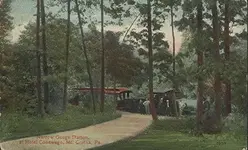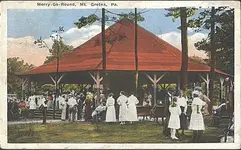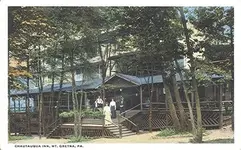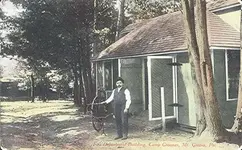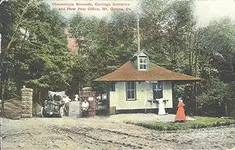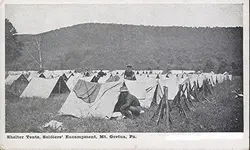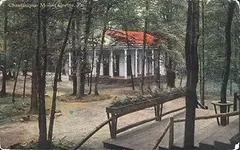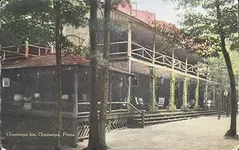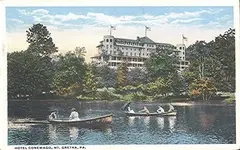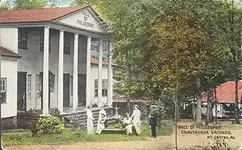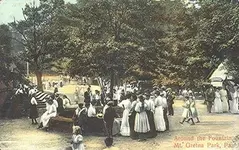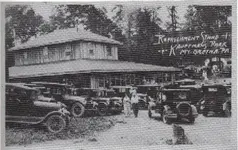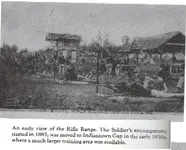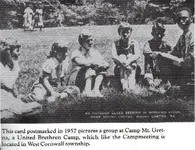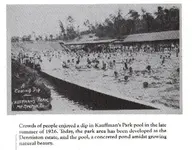Gypsy Heart
Gold Member
- #1
Thread Owner
Bob Coleman's interest in Mount Gretna far exceeded its importance to the affairs of his sprawling estate. In 1884, he ordered the area at the Mount Gretna station be converted into a recreation park. The floor of the park was cleared and picnic facilities installed among me springs and varied trees and plants. The following year, he invited the Pennsylvania 3rd Brigade to encamp at Gretna and had grounds adjacent to the park cleared. This was to be the summer home of the Pennsylvania National Guard for the next half century. That fall he ordered a dam constructed across Conewago Creek, and by the spring of 1886, Lake Conewago appeared, much as we see it today.
In 1890, Bob invited the Farmer's Encampment to Gretna and made all provisions, including the large building we see there today. A siding from the C & L was run in to the Park. Steam from an engine powered a generator which first lit the Park by electricity in August, 1890. By this time, the crowds drawn to Mount Gretna by the myriad of attractions and its sheer loveliness had swelled to 20,000 and more.
Historic perspective might suggest that all the foregoing was preparation for 1892 - the defining year in Mount Gretna's history. In 1891, dissension over commercial activities arose at the United Brethren camp meeting at Stoberdale. A committee was appointed to seek a new site. When they approached Bob Coleman, his response was instant. He leased them 30 acres across Conewago Creek from the park, cleared the area and gave each cottage owner at Stoberdale $120.00 to erect one at Mount Gretna on the lot of their choice. The lots were 20 feet by 24 feet with intention that they be occupied by tents but by the first camp meeting in August 1892, 100 cottages had been built.
Services that year, and until 1899, were held in an open "temple area." The tabernacle did not appear until 1899.
At the same time, meetings had been held in Lebanon and committees formed to create a Pennsylvania Chautauqua, patterned after that in New York state. Again, Bob Coleman responded generously and the committee chose a site adjacent to the camp meeting grounds, with Old Pinch Road between them. By the time the first Chautauqua was held in July, 1892, a dozen cottages, several public buildings and the Auditorium designed by John Cilley had been erected. The Inn followed in 1898, and the Hall of Philosophy in 1909.
From that first year of 1892, camp meeters and Chautauquans alike embraced Mount Gretna as their summer home, and their stays extended from Memorial Day to Labor Day. And alike they reveled in the intimate, friendly communion which the delightful woodland surroundings engendered. It was inevitable that Mount Gretna would become one of the most charming summer resorts in the Nation, and after World War II, to begin transition to a year-round residential area which is virtually unique.
The Conewago Hotel was built in 1909, and overlooked the Lake until just before World War II. It fell victim to the automobile, the depression and movement of the National Guard encampment to Indiantown Gap
In 1890, Bob invited the Farmer's Encampment to Gretna and made all provisions, including the large building we see there today. A siding from the C & L was run in to the Park. Steam from an engine powered a generator which first lit the Park by electricity in August, 1890. By this time, the crowds drawn to Mount Gretna by the myriad of attractions and its sheer loveliness had swelled to 20,000 and more.
Historic perspective might suggest that all the foregoing was preparation for 1892 - the defining year in Mount Gretna's history. In 1891, dissension over commercial activities arose at the United Brethren camp meeting at Stoberdale. A committee was appointed to seek a new site. When they approached Bob Coleman, his response was instant. He leased them 30 acres across Conewago Creek from the park, cleared the area and gave each cottage owner at Stoberdale $120.00 to erect one at Mount Gretna on the lot of their choice. The lots were 20 feet by 24 feet with intention that they be occupied by tents but by the first camp meeting in August 1892, 100 cottages had been built.
Services that year, and until 1899, were held in an open "temple area." The tabernacle did not appear until 1899.
At the same time, meetings had been held in Lebanon and committees formed to create a Pennsylvania Chautauqua, patterned after that in New York state. Again, Bob Coleman responded generously and the committee chose a site adjacent to the camp meeting grounds, with Old Pinch Road between them. By the time the first Chautauqua was held in July, 1892, a dozen cottages, several public buildings and the Auditorium designed by John Cilley had been erected. The Inn followed in 1898, and the Hall of Philosophy in 1909.
From that first year of 1892, camp meeters and Chautauquans alike embraced Mount Gretna as their summer home, and their stays extended from Memorial Day to Labor Day. And alike they reveled in the intimate, friendly communion which the delightful woodland surroundings engendered. It was inevitable that Mount Gretna would become one of the most charming summer resorts in the Nation, and after World War II, to begin transition to a year-round residential area which is virtually unique.
The Conewago Hotel was built in 1909, and overlooked the Lake until just before World War II. It fell victim to the automobile, the depression and movement of the National Guard encampment to Indiantown Gap




